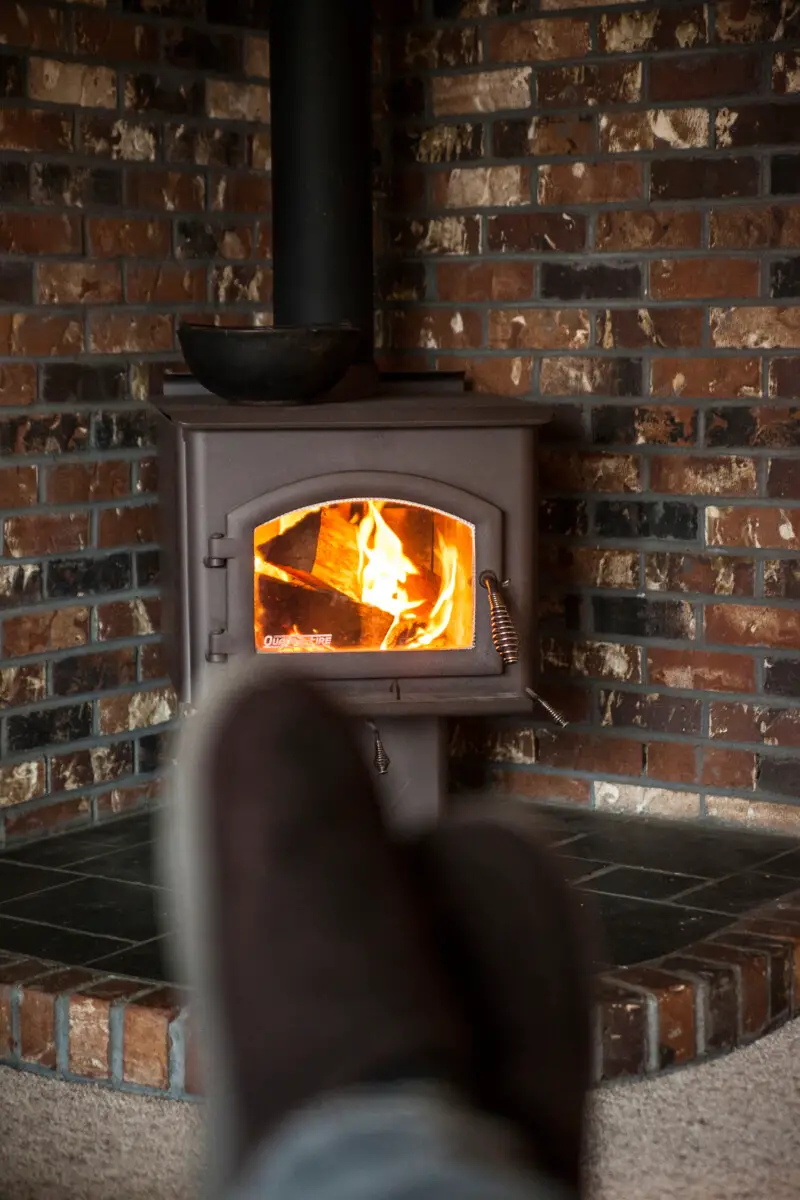With the weather cooling down here in the southern hemisphere our attention turns to heating. We recently upgraded our woodheater’s flue and it got me thinking about the pro’s and con’s of this type of heating.
Wood-fired heaters can produce a lot of pollution if not used correctly. They can also be a regenerative and effective source of heating and cooking in a time when gas, oil, and coal heating are becoming more and more expensive. Like everything in life, we must temper the good with the bad and design solutions that are better for the planet and those that inhabit it.

Are wood fires bad for your health?
The population-wide health impacts of outdoor biomass smoke have been far less extensively studied than the more dominant causes of urban air pollution that mostly comes from burning fossil fuels for industry or transport. But the evidence is growing.
Bushfire smoke and the smoke produced by wood heaters have much in common. They, along with tobacco smoke, are examples of biomass smoke – emissions that come from burning organic matter such as grass, leaves or wood.
Biomass smoke is a toxic soup of hundreds of different chemicals that includes many well-known toxins and carcinogens.
Are wood heaters bad for the environment?
Perhaps the gravest impact to keep in mind is air pollution. Burning wood releases a great deal of particulate matter. These tiny particles can cause a host of respiratory problems, and research suggests that kids growing up in homes heated with wood experience more frequent respiratory problems. Wood smoke also contains several toxic air pollutants, including benzene and formaldehyde — both listed as potential carcinogens by the Centers for Disease Control.
This air pollution is nothing to sniff at. In some communities, up to 80 percent of the particulate matter emitted in the wintertime comes from wood smoke. And a study by the Canadian government reports that even using a high-efficiency wood stove for two-and-a-half days emits as much fine particulate matter as a car does in a year.
In addition to this burning wood unloads all the bound up carbon that is stored within the tree that has been cut for firewood. That can amount to several tons of CO2 in some cases. Greenhouse gases are directly linked to the heating of the planet and climate change.
Are wood heaters safe?
Flue Safety
Now that winter is well and truly upon us, the prevalence of house fires caused by debris igniting in the flue is a real risk. Flues that have not been cleaned and maintained correctly can become a big fire risk. We often hear of homes being lost to fire in winter due to faulty equipment or poorly maintained fireplaces. Birds contribute to this as well. Believe me when I tell you the birds love to build their nests with hay, feathers, bits of sheeps wool and hair from other animals in the chimney or flue during the spring. You will be unaware of it until the following winter when you hopefully have either contracted someone to clean and check the flue before you light your first winter fire. You may be handy enough to do this yourself but you will need a long handled wire cone brush to clear any debris completely.

One sign of a partially blocked flue or chimney is a fire that creates a lot of smoke which will come back down into the room rather than escaping up the flue. This often results in sore eyes, stuffy noses and breathing difficulties. More dangerous than that, the heat and sparks generated within the blocked chimney can ignite resulting in a chimney fire and possible destruction of the home. Many people also like to slow burn the woodheater overnight – this can result in the building of creosote within the chimney causing a smelly, smoking and inefficient burn.
Choose the right heater
When deciding to install a woodburning heater it is important to investigate not only the cost, versatility, and aesthetics but also the safety and emissions. Many local governments have moved to ban or restrict the use of wood heaters so don’t forget to check your local regulations as well.
There are many effective models on the market these days and rather than go through them all I will simply point out that the more efficient the firebox and chimney construction the less likely you are to be adding to pollution levels.
Inefficient burning results in the emissions of potent greenhouse gases such as methane and wastes energy that could otherwise be heating the home. You can find detailed advice on how to minimise pollution from your wood heater on many websites but the above link from Tasmania is one of the better I have seen.
Probably the single most important thing to remember is to open the air vent fully each time new wood is added to the fire and then allow it to burn hot for 20 minutes before reducing the air intake. It’s especially important never to completely close the air intake.
Smoke should almost never be visible from a working chimney, but I still count numerous thick plumes on my way home every night. We clearly have a long way to go before efficient operation of wood heaters becomes the norm.
I still love wood heaters, but owning one means owning its pollution and doing everything we can to reduce it.
Effectiveness of using Smart Burn
One product we have found well worth the cost is the Smart Burn (often available on special for around $40). Despite the advertisers claims that it will last 3 months, our experience is that when the fire is used only in the evenings and on cloudy or wet days (when the thermal efficiency of our home is at its lowest) the Smart Burn lasts us a full season (4 – 5 months). The product assists with cleaner burning and reduction in smoke when the fireplace door is open. Our fireplace does not have a glass door but friends tell me they experience less soot build up on the glass as well with this product.
Firewood Management
We are fortunate to have our own firewood on our farm and selectively clear only dead trees for safety each year. We always replant at least twice the number of trees we remove to ensure there is always replacement coming along. Some species you may not be familiar with for fire wood include Black Wattle (we use this predominantly in rocket stoves and as kindling) Queensland Iron Bark is the prize though and it is getting harder and harder to find. Most firewood sellers in Australia will sell you this rich red and very dense wood. It is very good for fire wood but takes several years to reestablish. Hence the reason we always plant twice as many as we take. (Fair Share and Earth Care) We also use Yellow Box and Stringy Bark for Fire Wood and it is more than acceptable provided it is well dried.

After cutting down dead wood trees or branches we remove the twiggy pieces and dry them for use as kindling – nothing is wasted. Sawdust is used to put back into the earth via compost or seedling mixes. Once the twigs are removed everything else is cut into appropriate lengths and stacked to continue the drying process. Larger logs are kept seperate for use as totem poles for fencing or mushroom growing or just for later splitting. We don’t cover the pile but leave it to open air. As the timber shrinks further the bark tends to fall off to be used as mulch in the gardens. Now and again I spy a nice gnarled piece and will take it for use in the garden or to create habitat.
Firewood should be hardwood to achieve maximum heat and a longer burn time. Radiata Pine should never be burned in an indoor fireplace. The smoke from treated pine is highly toxic and the wood itself burns too fast and produces too much ash to make it worthwhile. It is also likely to clog up your flue.
When cleaning out the firebox (the area that collects the ash) if you have burrowing animals sprinkle the ash thickly in sections around the area of concern to deter them. This is particularly effective for rabbits.
Homemade Firestarters
Home made fire starters can be a great cost saving idea but always keep them safe from the children and animals.
We use homemade firestarters as a form of recycling. Used teabags are dried on an old oven rack outside in the sun before being placed in a jar containing methylated spirits to soak ready for use. We tend to only need 1 at a time to get the fire going.
Other people i know use compressed newspapers as fire brickettes. To make these simply tear up your newspapers into small strips, soak in a bucket of water until very wet. Lightly spray an icecube tray with oil and squeeze out small handfuls of paper into balls and drop in icecube tray to or similar form to dry. When dry enough to turn out – dry them in the sun until hard. These work just like the brickettes you buy in the store.
Conclusion
As with all things we do to try to be more sustainable there are both pros and cons for the wood fired heater. Ultimately, the decision is yours but I feel that being more focused on managing our homes in a solar passive manner will become more and more necessary in the future. If we are thoughtful about our use of wood heaters and manage the resources needed by replanting appropriate firewood trees when we take from nature we will have the ability to continue to use this wonderful form of heating for many years to come.



